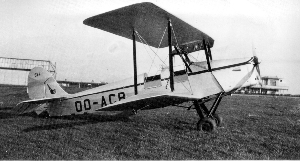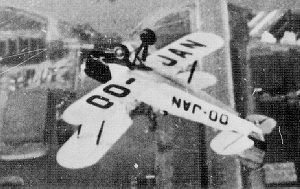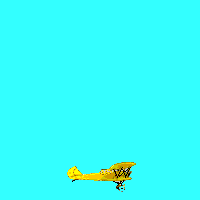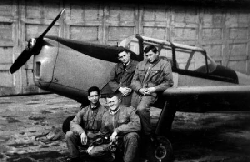

The Background
The Stamp company was created in 1923 and located in the airport of Anvers-Deurne in Belgium. Their founders were Jean Stampe (ex-pilot of the King Albert of Belgium) and Maurice Vertongen (ex-WW1 Pilot). It soon became an important flying school handling also air transport and other related activities. In 1930 they became representatives of De Havilland when they sold "Moth's" and "Puss Moth's". They became to built aeroplanes based on the design of Alfred Renard such as the RSV series (RSV32, 26, 26/100, 18/26, 22). A. Renard left the company to form his own business and was replaced by a young engineer, called Georges Ivanow who brought further improvements (ST26, RSV32G11, SV3).
The first SV4
 In
1932, George was asked to study a new aircraft and thus the SV4 was born
in 1933 (first flight the 13 May 1933). It received its certificate on
May 26, 1933 and was registered as OO-ANI. It weight 760 Kg, powered by
a motor Gipsy Major, cruising speed 140 Km/h with an initial climbing speed
of 3.9 m/sec. The aircraft was quickly put to service and between 1933
and 1938, 6 were built (00-ANK, OO-AAC, OO-ACB, OO-APR, OO-ASU).
In
1932, George was asked to study a new aircraft and thus the SV4 was born
in 1933 (first flight the 13 May 1933). It received its certificate on
May 26, 1933 and was registered as OO-ANI. It weight 760 Kg, powered by
a motor Gipsy Major, cruising speed 140 Km/h with an initial climbing speed
of 3.9 m/sec. The aircraft was quickly put to service and between 1933
and 1938, 6 were built (00-ANK, OO-AAC, OO-ACB, OO-APR, OO-ASU).
However, following an air crash on a twin engine SV10 which caused the death of Georges Ivanow and Leon Stampe (son of Jean) in 1935, Stampe and Vertongen ceased all aircraft designing and building activities and concentrated on maintenance activities.
The SV4 Second Serie
 Under
repeated requests from Elza Leyzen, ex-student pilot of Jean Stampe, he
finally agreed to re-open the SV4 files to built an aerobatic aeroplane
"Made in Belgium". B. Demidoff, his new engineer went to work
and so was born OO-JAN on 19 October 1937. Maximum weight of 825 kg, rated
for aerobatics with a VNE of 385 km/h. It first flew with a upright Gipsy
engine thereafter with a Gypsy major. Although it had received the approbation
of the Belgian Air Force, no orders came through. A second exemplar was
built for the Brussels Flying Club in 1938.
Under
repeated requests from Elza Leyzen, ex-student pilot of Jean Stampe, he
finally agreed to re-open the SV4 files to built an aerobatic aeroplane
"Made in Belgium". B. Demidoff, his new engineer went to work
and so was born OO-JAN on 19 October 1937. Maximum weight of 825 kg, rated
for aerobatics with a VNE of 385 km/h. It first flew with a upright Gipsy
engine thereafter with a Gypsy major. Although it had received the approbation
of the Belgian Air Force, no orders came through. A second exemplar was
built for the Brussels Flying Club in 1938.
The SV4B
 In 1939, in order to resubmit the SV4 to the competition organised by the
Belgian Air Force to replace their current aeroplanes (AVRO530), Demidoff
reviewed the drawing of OO-JAN and simplified the aircraft. Two aircraft
were built OO-ATC and OO-ATD. With the approval of the submission, the
second aircraft was sold to the baron Thierry d'Huart.
In 1939, in order to resubmit the SV4 to the competition organised by the
Belgian Air Force to replace their current aeroplanes (AVRO530), Demidoff
reviewed the drawing of OO-JAN and simplified the aircraft. Two aircraft
were built OO-ATC and OO-ATD. With the approval of the submission, the
second aircraft was sold to the baron Thierry d'Huart.
In July 1939, Jean Stampe took OO-ATC to France where with the assistance
of Michel Detroyat, it was presented both at the French Air Force and Artillery.
Jean Stampe returned to Belgium, in his pocket an order for 30 SV4B ( or
Bis to differentiate from the 8 previously built SV4) for the French Air
Force.
The same month, OO-ATC was presented at the Brussels International Air
Meeting, flown by the Lt Phillipart and obtain a tremendous success. It
appeared then that the SV4B was destined for a great future....However,
on September 3, Germany invaded Poland...
The War Period
In earnest, production started in Deurne(Belgium) in December 1939 and the last was delivered on 13 may 1940. Of the 30 built, 24 survived the "débacle", shipped to North Africa and recuperated by the FAFL in 1943 where they were put in services for liaison. In September 1939, France placed an additional order for 300 SV4. Due to the incapacity for the Belgian firm to built such a large series, they sought through Farman in France facilities to built the SV4. Finally agreement were concluded in January 1940 for 400 SV4B for the French Air Force and 200 others for the Artillery. The Belgian were to produce the first 50 SV4 however 10 only were built before the armistice. One aeroplane was tested in Belgium, the frame of the nine remainder were shipped on a barge towards Lyon but were caught by the Germans and disappeared.
OO-ATD escape to Great Britain!
 One
of the 2 SV4 (OO-ATD) built originally for the submission in 1939 and sold
to baron Thierry d'Huart, had been hidden in the gardener shed of his castle
of Ter-Blok. On the 4 July 1941, it was "borrowed" by 2 Belgian
pilots Michel Donnet and Leon Divoy and flown to Great Britain. In 1945
when Belgium was liberated, it was flown back to its rightful owner. OO-ATD
flew till 1957 when it was given to the Belgian Air museum where it can
be seen today! OO-ATD was the only survivor of all the SV4 built before
the war.
One
of the 2 SV4 (OO-ATD) built originally for the submission in 1939 and sold
to baron Thierry d'Huart, had been hidden in the gardener shed of his castle
of Ter-Blok. On the 4 July 1941, it was "borrowed" by 2 Belgian
pilots Michel Donnet and Leon Divoy and flown to Great Britain. In 1945
when Belgium was liberated, it was flown back to its rightful owner. OO-ATD
flew till 1957 when it was given to the Belgian Air museum where it can
be seen today! OO-ATD was the only survivor of all the SV4 built before
the war.
Post WW2 The Belgian Serie
 In 1944, Jean Stampe's factory had been destroyed by the V.1.; in 1947
Stampe and Vertongen renewed their partnership with their original companion
Alfred Renard to form the Stampe et Renard Co. They redesigned the SV4B,
introduce a more powerful engine, the Gipsy Major series X of 145 Hp and
introduce the sliding canopy. The Belgian Air Force wanted to replace their
"Tiger Moth" and ordered 65 SV4B in 1947 for their "Ecole
de Pilotage Elementaire" (Basic Flying Training...Which by the way
were not so elementary!!). The last SV4B came out of the production line
on the 7 October 1955. ( It was in fact identified as SV4D since it was
equipped with a Continental engine and registered as OO-SRS. It is now
the property of the Belgian Air Museum). The Belgian Air Force pilots started
their flying training on SV4B until these were replaced in 1969 by the
Marchetti SF260. The end of a beautiful era!
In 1944, Jean Stampe's factory had been destroyed by the V.1.; in 1947
Stampe and Vertongen renewed their partnership with their original companion
Alfred Renard to form the Stampe et Renard Co. They redesigned the SV4B,
introduce a more powerful engine, the Gipsy Major series X of 145 Hp and
introduce the sliding canopy. The Belgian Air Force wanted to replace their
"Tiger Moth" and ordered 65 SV4B in 1947 for their "Ecole
de Pilotage Elementaire" (Basic Flying Training...Which by the way
were not so elementary!!). The last SV4B came out of the production line
on the 7 October 1955. ( It was in fact identified as SV4D since it was
equipped with a Continental engine and registered as OO-SRS. It is now
the property of the Belgian Air Museum). The Belgian Air Force pilots started
their flying training on SV4B until these were replaced in 1969 by the
Marchetti SF260. The end of a beautiful era!
 |
 |
| My flying debut, first solo on SV4 number 26 on November 21, 1966! | The young brother of the SV4, the SR7 which came for evaluation at the E.P.E. but eventually, the Marchetti SF260 replaced the SV4B |
[Home]
[Irish Wolfhounds]
[Our Clan]
[The Stamp]
[Links]
This page was modified 17 June, 1997
| LinkExchange Member | Free Home Pages at GeoCities |